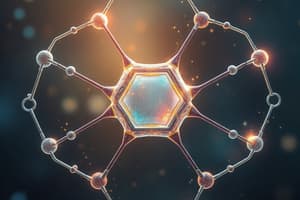Podcast
Questions and Answers
What is the central element studied in organic chemistry?
What is the central element studied in organic chemistry?
- Nitrogen
- Carbon (correct)
- Hydrogen
- Oxygen
How many valence electrons does carbon typically have?
How many valence electrons does carbon typically have?
- 6
- 4 (correct)
- 2
- 8
What is the importance of functional groups in organic chemistry?
What is the importance of functional groups in organic chemistry?
- They increase carbon's valence electrons
- They provide stability through resonance
- They have characteristic reaction patterns (correct)
- They are the primary source of energy in living organisms
Which type of compounds does inorganic chemistry primarily focus on?
Which type of compounds does inorganic chemistry primarily focus on?
What characteristic of carbon allows it to form chains or rings in molecules?
What characteristic of carbon allows it to form chains or rings in molecules?
Which of the following is NOT a compound commonly found in organic chemistry?
Which of the following is NOT a compound commonly found in organic chemistry?
Which functional group is present in aldehydes and ketones?
Which functional group is present in aldehydes and ketones?
What is the molecular geometry of ethane (C₂H₆)?
What is the molecular geometry of ethane (C₂H₆)?
What type of overlap between adjacent atoms leads to resonance structures?
What type of overlap between adjacent atoms leads to resonance structures?
Which class of organic compounds often exhibits resonance due to delocalization of electrons?
Which class of organic compounds often exhibits resonance due to delocalization of electrons?
In electrophilic substitution, where do electrophiles typically form new bonds?
In electrophilic substitution, where do electrophiles typically form new bonds?
What type of process involves nucleophiles attacking polarized bonds to replace leaving groups?
What type of process involves nucleophiles attacking polarized bonds to replace leaving groups?
Flashcards are hidden until you start studying
Study Notes
Organic Chemistry
Organic chemistry is a branch of chemistry concerned with the study of carbon compounds. Carbon has unique properties due to its ability to form strong bonds with other atoms while maintaining many bonding sites. This flexibility allows it to create complex molecules and structures found in living organisms. Inorganic chemistry, by contrast, focuses on non-carbon compounds.
Carbon's four valence electrons allow it to form single covalent bonds with up to four different atom types. These bonds can also combine to form chains or rings, resulting in various molecular arrangements. The vast variety of possible configurations gives rise to a wide range of compounds in organic chemistry. Some examples of these compounds include sugars, amino acids, fats, oils, polymers like nylon and polyethylene, and drugs such as aspirin and penicillin.
The central role of hydrogen in organic compounds adds another layer of complexity. Hydrogen atoms typically form only one bond, which may involve sharing one electron from each atom involved. This leaves two unpaired electrons free to participate in additional chemical reactions. Additionally, the carbon-hydrogen double bond, where both pairs of electrons share the same space, provides stability through resonance.
In organic chemistry, functional groups are key structural elements that have characteristic reaction patterns. Examples of functional groups include alcohol (-OH), alkane (-CH₃), carbonyl group (C=O) in ketones and aldehydes, carboxylic acid (-COOH), ether (-OC-O-), and halogen (-Cl, -Br).
Important Concepts in Organic Chemistry
Molecular Geometry and Bond Angles
As mentioned earlier, carbon forms multiple bonds in organic compounds. These bonds lead to different molecular geometries depending on whether they are single, double, triple, or ring structures. For example, ethane (C₂H₆) has three C-H bonds in a tetrahedral arrangement around the central carbon atom. When a double bond replaces one of those single bonds, as in ethene (C₂H₄), the remaining single bonds adopt a staggered conformation. Finally, when all bonds are double, as in ethyne (C₂H₂), the molecular geometry becomes linear.
Resonance Structures
Resonance occurs in certain classes of organic compounds, particularly conjugated systems like benzene, where delocalization of electrons leads to more stable molecular orbitals. Electron delocalization results in shared pi and sigma orbital overlap between adjacent atoms, leading to resonance structures. A common example is benzene, which shows six equivalent resonance structures, indicating that there is no preferred structure.
Reaction Mechanisms
A variety of mechanisms guide how organic molecules undergo change. Commonly studied processes include nucleophilic substitution, electrophilic substitution, elimination, and addition. Nucleophiles act as attacking species, adding their negative charges across a polarized bond, usually to replace a leaving group. Examples include S_N1 displacement and SN2 reactions. Electrophiles, conversely, attract electrons, often in areas with low electron density, such as alkenes and aromatic rings, forming new carbon-carbon bonds during electrophilic substitution or addition.
Applications and Significance of Organic Chemistry
Organic chemistry impacts numerous fields beyond academia. Its applications span from pharmaceuticals to materials science and nanotechnology. Drugs, paints, dyes, cosmetics, plastics, rubber, photographic film, detergents, and pesticides all stem from organic chemistry. It also contributes significantly to our understanding of biochemical pathways within living organisms and plays a crucial role in environmental issues surrounding petroleum refining, pollution control, and waste management.
Studying That Suits You
Use AI to generate personalized quizzes and flashcards to suit your learning preferences.




